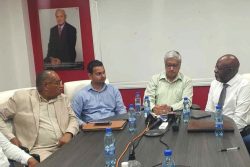Dear Editor,
I appreciated Harry Hergash’s sharing the episodes of long-ago life in Eastern Mahaicony and his highlights of some extraordinary African lives in his native village (SN, Feb. 22). I echo the sentiments of several bloggers who felt that such narrations should be preserved for posterity.
Mr. Hergash (my respected former high school teacher) explained that his father was educated by the Presbyterian Canadian Mission (CM) School and surmised that, “The CM focused on the education of East Indian children, mainly Hindus and to a lesser Muslims, with the aim of gaining converts to Christianity.”
I beg to disagree with Harry on this point – especially regarding his reference to the situation in India. The Canadian Mission and other Christian outfits in and out of India did not establish schools to “gain converts”; instead, they aimed to educate folks on the periphery and those who were marginalized because of their educational, economic or social status. They wanted to touch lives and lift the feel of those that were stuck in the dark and miry clay.
Why did Christians establish schools and hospitals in India? Why did the British fight against traditions such as ‘Sati’ (the act or custom of a Hindu widow burning herself to death or being burned to death on her husband’s funeral pyre)? Who spearheaded work in the leprosy mission and dared to touch and clean the lepers? And what about the Blind Schools in India? Were all these institutions established “to gain converts”? No! The objective was motivated by holistic love to meet people’s needs – as much as possible. I have met several persons in Guyana (Christians and Hindus) who narrated stories of how the Canadian Mission played an essential part in their lives to educate them and respect and appreciate their ancestral language (Hindi), music and culture. The CM apprised Harry’s father, but he never changed his faith and was never pressured to become a Christian (as far as I know). Ditto for thousands of other East Indians in the country.
(I attended the New Market Anglican School in No. 63 Village in the Corentyne. There was no pressure from anyone for me or other Hindu students to change our faith). I visited the Cropper Primary School in Albion in Guyana a few years ago. I was dismayed that none of the residents or children I encountered in that neighbourhood had any notion of who ‘Cropper’ was. I feel that there ought to be a statue of Rev.
James Cropper at that school whereby students and others could be educated about the critical role that man and others like him had played in uplifting the lives of Indians in British Guiana. The Indian people of Guyana ought to be grateful for the Canadian Mission’s enormous contributions to their dignity, upliftment and progress – especially in the areas of education, language, music and culture.
Sincerely,
Dr. Devanand Bhagwan





